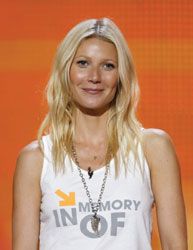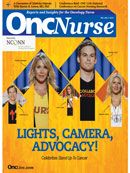Publication
Article
Oncology Nursing News
Lights, Camera, Advocacy! Celebrities Stand Up To Cancer
Author(s):
Celebrity advocacy takes the form of both individual crusades and collaborative efforts, such as Stand Up To Cancer (SU2C)

TMZ. Perez Hilton. Entertainment Tonight. People. InTouch Weekly. We intensely follow celebrities’ every move online, on TV, and in print. The media attention gives celebrities tremendous influence over our public discourse. Stars frequently use this outlet to speak out for various causes. This celebrity advocacy takes the form of both individual crusades and collaborative efforts, such as Stand Up To Cancer (SU2C).
A NEW APPROACH
SU2C was started in 2008 as a program of the Entertainment Industry Foundation, the entertainment industry’s leading charity organization. SU2C’s 9 cofounders were each affected by cancer, either personally or through a loved one. They were dismayed at the lack of communication they witnessed between doctors and researchers in the oncology community. Despite breakthroughs in the science and technology of cancer, the lack of collaboration seemed to be obstructing real progress.
Less competition, greater collaboration, and quicker results thus became the rallying points of SU2C. The cofounders collaborated with major cancer researchers to devise an entirely new funding model to emphasize these goals. They then began the process of raising the funds needed to implement the program.
SU2C FUNDRAISING
SU2C primarily generates funds through a biennial celebrity telethon. The organization also has a group of major donors, led by Major League Baseball.
SU2C Goes Live
The first hour-long, commercial-free SU2C telethon was simulcast live on ABC, NBC, and CBS in September 2008. The broadcast reached 170 countries and included a bevy of major celebrities. Sherry Lansing, a cofounder of SU2C and former chair of the Motion Picture Group of Paramount Pictures, told OncLive Nursing that when it comes to cancer, “Celebrities are no different than anybody else; everybody on the show has been touched by cancer in some way.” Shortly after the telethon, SU2C announced that it had raised over $100 million for cancer research since its launch.
SU2C Dream Teams
SU2C’s 5 Dream Teams are conducting translational research designed to quickly deliver results from the laboratory to the patient. For greater detail on the projects, go to http://bit.ly/dk97GC.
Cutting off the Fuel Supply: A New Approach to the Treatment of Pancreatic Cancer
LEADERS: Craig B. Thompson, MD, director, Abramson Cancer Center, the University of Pennsylvania; Daniel D. Von Hoff, MD, senior investigator and physician-in-chief, Translational Genomics Research Institute
The Pancreatic Dream Team is using advanced imaging techniques to determine which nutrients pancreatic cancer cells require for survival. Clinical trials will then be conducted to discover drug combinations that deprive pancreatic tumors of these nutrients.
Bioengineering and Clinical Applications of Circulating Tumor Cell Chip
LEADER: Daniel A. Haber, MD, PhD, director, Massachusetts General Hospital Cancer Center
The CTC Dream Team is optimizing the clinical application of the CTCChip, a microfluidic chip that can capture CTCs for scientific analysis. The researchers are examining the CTCChip’s value in early cancer detection and determining treatment efficacy.
Bringing Epigenetic Therapy to the Forefront of Cancer Management
LEADER: Stephen B. Baylin, MD, deputy director, the Sidney Kimmel Comprehensive Cancer Center at Johns Hopkins
The Epigenetic Dream Team is creating biomarkers to assess the effectiveness of epigenetic treatments and conducting clinical trials designed to facilitate the integration of epigenetic treatment into clinical practice.
Targeting the PI3K Pathway in Women’s Cancers
LEADER: Lewis C. Cantley, PhD, director, Cancer Center at Beth Israel Deaconess Medical Center
The focus of the PI3K Dream Team is to find molecular biomarkers for PI3K inhibitors in patients with breast, ovarian, and endometrial cancers. The researchers also hope to discover effective treatment combinations for patients with PI3K mutations.
An Integrated Approach to Targeting Breast Cancer Molecular Subtypes and Their ‘Resistance’ Phenotypes
LEADERS: Joe W. Gray, PhD, Life Sciences Division director, Lawrence Berkeley National Laboratory; Dennis J. Slamon, MD, PhD, director of clinical/ translational research, UCLA’s Jonsson Comprehensive Cancer Center
The Breast Cancer Dream Team is working to develop more effective treatments for estrogen receptor—positive, HER2-positive, and triple-negative breast cancers. A key element of the research involves examining how tumor cells become resistant to treatments that are initially effective.
SU2C Telethon: Take Two
With the success of its initial broadcast, SU2C easily attracted major celebrity participation to its second telethon in September 2010. Some of the celebrity participants included Christina Applegate, George Clooney, Cindy Crawford, Michael Douglas, Sally Field, Michael C. Hall, Diane Lane, Jay Leno, Rob Lowe, Tobey McGuire, Gwyneth Paltrow, Seth Rogen, Adam Sandler, Ryan Seacrest, Will Smith, Denzel Washington, Reese Witherspoon, and Renée Zellweger.
The hour-long program was broadcast live and commercial-free on ABC, CBS, FOX, NBC, and several other networks. Network news anchors Katie Couric (a founding member of SU2C), Diane Sawyer, and Brian Williams hosted the program, which was seen in 195 countries. The telethon raised >$80 million.

The tremendous response to its fundraising efforts allowed SU2C to implement its innovative funding model. The model consists of 2 scientific grants, Dream Team Grants and Innovative Research Grants (IRGs), designed to facilitate greater collaboration and accelerated results in cancer research. The grants were created in collaboration with SU2C’s scientific partner, the American Association for Cancer Research (AACR).
Dream Team Grants fund multidisciplinary, multi-institutional groups of scientists whose research can benefit patients in the near-term. IRGs support highrisk, high-reward projects with the potential to significantly impact cancer care.
The grants are awarded and administered by the AACR’s Scientific Advisory Committee (SAC), which is chaired by Nobel Laureate Phillip A. Sharp, PhD, Institute Professor at the Massachusetts Institute of Technology and the David H. Koch Institute for Integrative Cancer Research. SAC vice chairpersons include Brian J. Druker, MD, director, Oregon Health & Science University Cancer Institute, Portland, and Arnold J. Levine, PhD, professor, Institute for Advanced Study and Cancer, Institute of New Jersey, Princeton. The remaining committee members comprise 15 prominent cancer researchers and physicians, along with 2 patient advocates.
Dream Teams
SU2C announced the selection of the first 5 Dream Teams (see sidebar) in May 2009. The Teams comprise >300 total participants from >20 major cancer research institutions. Each Dream Team is conducting groundbreaking “translational” research designed to quickly move results from the “bench to the bedside.” The teams each received 3-year grants, and the total award amount was $73.6 million.
The SAC selected the 5 Dream Teams from 237 total submissions. In an interview with OncLive Nursing, Sharp discussed some of the factors the SAC considered. “Teams had to be doing innovative and important cancer research. [They also] had to be either engaged in clinical programs—meaning they’re [currently reaching] patients—or very close to it.” The SAC also examined the likelihood of success, whether the projects addressed key research problems, and the various applicants’ collaborative potential. “We wanted people who…were committed to being a team,” Sharp said.
The leader of the “Targeting PI3K in Women’s Cancers” (www.pi3k.org) Dream Team, Lewis C. Cantley, PhD, director, Cancer Center, Beth Israel Deaconess Medical Center and professor of systems biology at Harvard Medical School, and chief of the division of signal transduction at Beth Israel Deaconess Medical Center, discussed his project with OncLive Nursing.

The phosphatidylinositol 3-kinase (PI3K) pathway is involved with cell growth and survival. Mutations in genes that regulate the PI3K pathway promote the development and growth of tumors. Several targeted therapies that inhibit the PI3K pathway are being tested in ongoing clinical trials; however, molecular biomarkers are still needed to determine which patients should receive the PI3K inhibitors. Finding these predictors is the goal of Cantley’s Dream Team.
Cantley and his Dream Team colleagues are the same researchers who discovered the PI3K pathway and its oncogenic properties. Their new research is focusing on breast, ovarian, and endometrial cancers, which have all been shown to have the PI3K mutation. After examining almost 2000 breast, ovarian, and endometrial cancers from 7 major cancer institutions, the team designed 10 phase II clinical trials, 2 of which are ongoing.
The design of the 10 PI3K trials varies from the traditional clinical setup. Patients are usually placed into cohorts that receive the same treatment over the entire trial. In contrast, the PI3K Dream Team’s “adaptive” trial design will use biomarkers and ongoing tests to determine treatment decisions throughout the trial. The adaptive mechanism quickens the feedback on the efficacy of various biomarkers and treatment regimes.
The trials are using both single-agent (PI3K inhibitors alone) and combination therapies. Cantley and colleagues are collaborating with pharmaceutical companies in their selection of investigational drugs for the trials. They hope to develop drug combinations that will strike multiple targets.
Cantley said the specific endpoints vary among the trials. “Most of the trials will look for a clinical response—tumor shrinkage—as the primary endpoint, although it depends on the type of cancer. In most types of breast cancer that we’ll be working with, to look for survival as an outcome requires [too] many years…We’re looking for trials that will have endpoints that are more rapid than that. [However] with inoperable endometrial cancer, the survival is less than a year, typically. So, in those trials, survival will be an outcome.”
Cantley attributes his project’s early success to the resources and collaborative process of SU2C’s funding model. “There really is no comparable NIH-funded or private-foundation- funded grant mechanism.”

SU2C Innovative Research Grants
SU2C Innovative Research Grants (IRGs) fund high-risk, high reward projects with the potential to revolutionize cancer research and treatment. Here are the first 13 IRGs, which were awarded in December 2009. To see the next set of 13 IRGs, which were awarded this month, go to http://bit.ly/gf47Gt.
An Emerging Tumor Suppressor Pathway in Human Cancer
Fernando D. Camargo, PhD, principal member of the Harvard Stem Cell Institute; assistant professor at the Children’s Hospital Boston and the Stem Cell Regenerative Biology Department at Harvard University
Modeling Ewing Tumor Initiation in Human Neural Crest Stem Cells
Elizabeth R. Lawlor, MD, PhD, assistant professor in the Departments of Pediatrics and Pathology at the University of Michigan
Cancer Cell Specific, Self- Delivering Pro-Drugs
Matthew Levy, PhD, assistant professor of Biochemistry at Albert Einstein College of Medicine of Yeshiva University
Targeted Inhibition of BCL6 for Leukemia Stem Cell Eradication
Markus Müschen, MD, director of the Leukemia Research Program at Children’s Hospital Los Angeles and the Leukemia and Lymphoma Program at the University of Southern California Norris Comprehensive Cancer Center; associate professor of Pediatrics, Biochemistry, and Molecular Biology at the University of Southern California, Keck School of Medicine
Identifying Solid Tumor Kinase Fusions via Exon Capture and 454 Sequencing
William Pao, MD, PhD, associate professor of Medicine, Ingram associate professor of Cancer Research, and director of Personalized Cancer Medicine at the Vanderbilt-Ingram Cancer Center
Therapeutically Targeting the Epigenome in Aggressive Pediatric Cancers
Charles M. Roberts, MD, PhD, assistant professor in the Department of Pediatrics at Harvard Medical School; assistant professor of Pediatric Oncology at the Dana-Farber Cancer Institute
Endogenous Small Molecules That Regulate Signaling Pathways in Cancer Cells
Rajat Rohatgi, MD, PhD, assistant professor in the Department of Medicine and Oncology at the Stanford University School of Medicine
Genetic Approaches for Next Generation of Breast Cancer Tailored Therapies
José M. Silva, PhD, assistant professor of Pathology at the Institute for Cancer Genetics at Columbia University Medical Center
Modulating Transcription Factor Abnormalities in Pediatric Cancer
Kimberly Stegmaier, MD, assistant professor in the Department of Pediatrics at Harvard Medical School; independent investigator in Pediatric Oncology at the Dana-Farber Cancer Institute; and attending physician in Pediatric Hematology-Oncology at the Children’s Hospital Boston and the Dana-Farber Cancer Institute
Noninvasive Molecular Profiling of Cancer via Tumor- Derived Microparticles
Muneesh Tewari, MD, PhD, assistant member in the Divisions of Human Biology, Clinical Research, and Public Health Sciences at the Fred Hutchinson Cancer Research Center; assistant professor in the Department of Medicine at the School of Medicine, University of Washington
A Transformative Technology to Capture and Drug New Cancer Targets
Loren D. Walensky, MD, PhD, attending physician and assistant professor of Pediatrics in the Department of Pediatric Hematology/ Oncology at the Children’s Hospital Boston, Dana-Farber Cancer Institute, Harvard Medical School
Functional Oncogene Identification
David M. Weinstock, MD, assistant professor in the Department of Medicine at Harvard Medical School; assistant professor of Medicine in the Medical Oncology Service at Dana-Farber Cancer Institute
Probing EBV-LMP-1’s Transmembrane Activation Domain with Synthetic Peptide
Hang (Hubert) Yin, PhD, assistant professor of Chemistry and Biochemistry and task force member of the Colorado Initiative in Molecular Biotechnology at the University of Colorado

Progress Reports
The 3-year funding of SU2C’s Dream Teams is contingent upon meeting established benchmarks. The SAC conducts periodic evaluations to ensure the projects are on course. The fi rst set of reviews took place in Summer 2010, and the results were encouraging. “We looked at the milestones they put in place and in almost every case the milestones had been met,” Sharp said.
Just as importantly, the SAC reviewed whether the Dream Teams were actually adhering to the collaborative design of SU2C’s funding model. “We looked at whether they were really functionally collaborating and, in all cases, that is going on in a real true sense,” Sharp said. To build on the synergy of this collaboration, Sharp intends to gather all the Dream Teams together to share their experiences.

IRGs
IRGs employ a high-risk, high-reward philosophy. Some members of the oncology community believe major innovations in cancer care are being hindered by an overly conservative approach to research. They believe researchers, concerned with obtaining funding, are not willing to engage in more unconventional, innovative approaches. IRGs seek to upend this conservative approach.
The IRG Review Committee of the SAC awards the grants to young scientists who present new ideas that challenge existing paradigms. SU2C hopes these fresh perspectives will accelerate the translational application of results to actual patient care. The projects are classified as high-risk because they do not require conventional grant prerequisites, such as the establishment of a supportive base of evidence. The first 13 IRGs (see sidebar), totaling $9.68 million, were awarded in December 2009. Each investigator received up to $750,000 over a 3-year period.
Cynthia Nixon and Edie Falco educate cancer patients in a new public service announcement
STAR POWER FUELS A MOVEMENT
SU2C’s advocacy and research efforts are continuously moving forward. “The TV shows are an every-other- year event, but we don’t stop. The Dream Teams continue, and we continue to raise money,” said Lansing.
SU2C has also become a movement beyond its high-profile broadcasts and research initiatives. The organization’s Website has developed a robust online community, and SU2C is encouraging grassroots and community advocacy efforts.
Regardless of these new endeavors, however, the heart of SU2C will always be its tremendous star power. In years without telethons, celebrity public service announcements (see video) maintain SU2C’s high profile on TV and the Internet. With its ambitious and innovative approach, SU2C has truly become a gold standard for celebrity advocacy.










